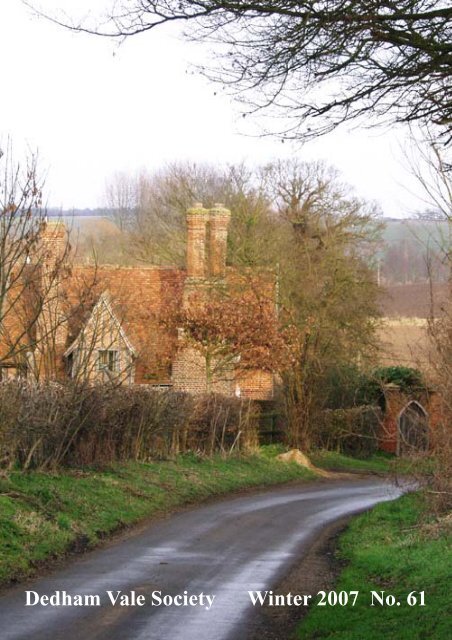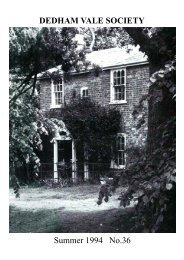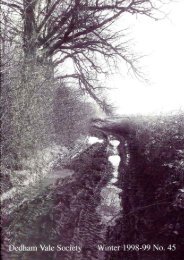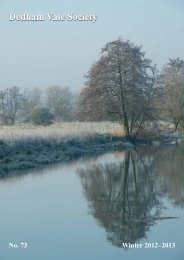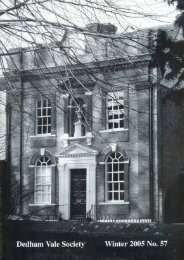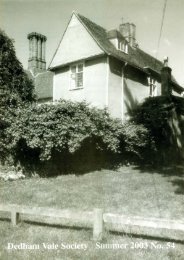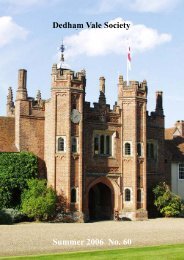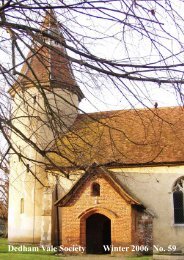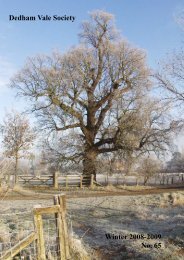Dedham Vale Society Winter 2007 No 61
Number 61 - Winter 2007 pdf 1.3Mb - Dedham Vale Society
Number 61 - Winter 2007 pdf 1.3Mb - Dedham Vale Society
- No tags were found...
Create successful ePaper yourself
Turn your PDF publications into a flip-book with our unique Google optimized e-Paper software.
<strong>Dedham</strong> <strong>Vale</strong> <strong>Society</strong> <strong>Winter</strong> <strong>2007</strong> <strong>No</strong>. <strong>61</strong>1
DEDHAM VALE SOCIETYPRESIDENTRobert Erith TD., D.L.CHAIRMANWilfrid TolhurstHONORARY TREASURERMichael ParkerJupes Hill House, <strong>Dedham</strong>Colchester CO7 6BJ01206 322133HONORARY SECRETARYSarah CarrGulson’s Farm, Boxted Church StreetColchester CO4 5SX01206 272207PLANNING OFFICER(Suffolk)David EkingFarthings, Thorington StreetStoke-by-Nayland CO6 4SP01206 337477PLANNING OFFICER(Essex)Roger DruryWoprkhouse Cottages, Workhouse LaneLittle Horkesley, Colchester CO6 4DS01206 271454NEWSLETTER EDITORPaul GallifantMill Cottage, Mill HillLawford, Manningtree, CO11 2JZ01206 394202MEMBERSHIP SECRETARYJohn OsbornBailey House, Brook Street,<strong>Dedham</strong>, Essex CO7 6AD01206 322157MEMBERS OF THE COMMITTEEMichael ArcherCharles CloverQuinlan TerryTel: 01206 322169Tel: 01206 323503Tel: 01206 337209Nella ProbertChristopher RobinsonAdam SedgwickTel: 01787 228095Tel: 01787 227179Tel: 01206 262437Front CoverShelley2
NEWSLETTER NUMBER <strong>61</strong> WINTER <strong>2007</strong>CONTENTSEditorial Page 4Planning <strong>No</strong>tes Suffolk Page 4Planning <strong>No</strong>tes Essex Page 5Meeting with CBC Planning Dept Page 7Neighbourhood Watch Page 9Undergrounding Cables Page 10Planning Guidelines Babergh Page 14Stop Stansted Expansions Page 15Hot Ideas for Heritage Projects Page 16Windows and Doors in Historic Buildings Page 17<strong>Dedham</strong> Seventy Years Ago Page 17Mistley, Manningtree and David Cleveland Page 20An empty river, <strong>Dedham</strong>, Autumn 20063
EditorialThe <strong>Society</strong> is fortunate in having the services of two new committee members. Roger Drury,who has taken on the role of Planning Officer for Essex, and Adam Sedgwick who will representthe Stoke by Nayland area. Roger refers, in ‘Essex Planning <strong>No</strong>tes, to the Buntings application atGreat Horkesley and it would appear from their publicity that the retail park is imminent. Itis presumptuous, to say the least, for them to claim that their ‘Country Park’ will soon beopening, ‘subject to planning permission’, as the slogan illustrated in the photograph of thedisplay van at the Asda Store near Colchester <strong>No</strong>rth Station states.The company is very confident but it will be disastrous for the <strong>Vale</strong> if they succeed.In this edition, the final part of the late Roger Freeman’s reminiscences appears and alsoanother of DVS member Maureen Cleave’s fascinating interviews with local people, thistime, David Cleveland, founder of the East Anglian Film Archive. Maureen’s articles, writtensolely for this publication, have regularly appeared in the DVS Newsletter over the years.I am indebted to her for the time and effort involved. (Editor)NOTES BY PLANNING SECRETARY, SUFFOLK – WINTER 2006-<strong>2007</strong>There has been no dramatic activity on the planning front in the AONB on the Suffolkside of the River Stour since I wrote my brief contribution for the Summer edition of themagazine in August 2006.The County Education Authority withdrew its application for an intrusive 18 metre high mastat East Bergholt High School and has agreed to look at alternative means of providing accessto the “School Broadband Network”. With luck this ugly structure may now not be built.Sympathetic and restrained plans to convert the former Rose Inn in Thorington Street intoa single private residence have been approved and work is well under way.Applications for minor extensions and in-filling continue apace, some more objectionablethan others .An unsatisfactory application to extend the Tower House, part of the originalbuildings of the Jane Walker Hospital above Wissington, has yet to be determined as havetwo applications for infilling in East Bergholt, both of which seek to cram their sites.Also waiting for decision are applications to erect new workshops and ancillaries at theLeavenheath Joinery on the edges of the AONB – a much reduced and refined proposal fromthat rejected earlier in the year- and one to build guest accommodation at the flourishingCrown Inn in Stoke by Nayland. This latter proposal makes considerable efforts to minimizeits impact on the views from the valley of the River Box within the AONB but it remainsintrusive for the near neighbours and it is questionable whether the roof level presentlyproposed is justifiable given that it only generates three extra rooms.Gravel pits have also reared their ugly heads again. The County Council’s proposalsinclude three which would affect the AONB, an extension of the existing Layham Quarry, anarea west of the Stoke by Nayland Golf Course in Leavenheath and a farm on the edges ofEast Bergholt. <strong>No</strong>ne are actually in the AONB but the development of any one of them wouldhave a noticeably detrimental impact on the area. The <strong>Society</strong> has registered its objection.I am very grateful to Adam Sedgwick of Downs House, Church Street, Stoke by Nayland,who has agreed to help me with applications affecting Stoke, stepping into John Frampton’sshoes.David EkingPlanning Secretary, Suffolk February <strong>2007</strong>4
ESSEX PLANNING NOTESThe <strong>Dedham</strong> <strong>Vale</strong> forms part of a totally unique cultural heritage where the views paintedby John Constable are present today and his progress through the <strong>Vale</strong> can be followed throughhis wonderfully atmospheric landscapes. If current and future generations are going to enjoythe <strong>Vale</strong> as it has been passed down to us a key to that enjoyment must be to maintain thepeace and tranquillity from the intrusions of the modern world.Two notable victories in defence of this the smallest of the Areas of Outstanding NaturalBeauty have been achieved in the last few months. Firstly the planning application from theEssex and Suffolk Gliding Club for a large increase in their powered flying days fromWormingford Airfield was withdrawn in the face of strong local opposition. A second successwas the rejection of an appeal against enforcement action taken by Babergh District Councilconcerning the use of a second runway at the Wissington by Nayland Airfield. We are all awareof the problem of the noise of aircraft passing over the <strong>Vale</strong> but locally generated noise is aserious issue in the west of the AONB. We must never be over-confident; these “disputes”have been running for over two decades and further battles will almost certainly lie ahead.However, the greatest threat to the whole of the AONB must be the Horkesley Park Heritageand Conservation Centre. When the third application was withdrawn in March 2006 in faceof local opposition, a full consultation process with the local community was promised – nosuch process appears to have taken place and a resubmission appears to be imminent. Here isnot the place to research the arguments on how this development would impact the whole ofthe <strong>Vale</strong>, it is enough to say that 750,000 visitors a year focused on Horkesley, Nayland andBoxted but spreading throughout the area on a totally inadequate infrastructure would bedevastating. With the developments associated with the rapid expansion of the East of England,it becomes even more important to protect the countryside from commercial exploitationwhilst encouraging the widest recreational opportunities for all.Having grown up on farms in Lincolnshire in the 1940s when the shire horse was anintegrated part of the working countryside, am I the only one who finds it deeply offensive to seethese magnificent Suffolk Punches paraded by Bunting & Sons at all manner of occasions andplaces including supermarket car parks? These are creatures of great beauty and we underminetheir dignity by parading them as fairground animals in furtherance of commercial gain.We must garner all our resources to oppose any development that would undermine thewonderful cultural heritage that we are privileged to experience today. The Stour ValleyAction Group will admirably lead the opposition and you can keep yourself informed atwww.stourvalleyactiongroup.org.ukAnother issue, which is likely to change the face of the countryside, is the movement ofagricultural subsidies from a production to conservation basis. Many farmers are looking at awide range of diversification projects, which will bring opportunities, including rural employment,to the countryside. However, the vision of redundant farm buildings being turned into lightindustrial use could, and indeed would, change the very nature of the <strong>Vale</strong>. Such developmentsmust be monitored to ensure that any change of use is sympathetic to the environment.I will detail here the proposed chicken farm at Cherry Tree Farm in the heart of GreatHorkesley, the subject of great debate and anger, as this lies outside the AONB but could be asign of things to come.Above I have concentrated on the major threats to the <strong>Vale</strong>. However, much smaller issuescan have, collectively, a serious impact on the enjoyment of the environment we all treasure.The inappropriate and unsympathetic building or extension, the proliferation of street signs,the excessive, and often unnecessary street lighting, all impact on the countryside. Whilst wemust concentrate on the “big issues”, we must also be alert to the small issues that change thenature of what we enjoy today. (Roger Drury, Essex Planning Secretary)5
Bunting’s publicity machine at Asda, <strong>No</strong>rth Station, ColchesterTheir claim enlarged!!6
MEETING WITH CBC PLANNING DEPARTMENTFriday 7 December 2006The purpose of this file note is to record discussions held between the <strong>Dedham</strong> <strong>Vale</strong> <strong>Society</strong>(Wilf Tolhurst, Chairman) and Roger Drury (Planning Secretary – Essex) and the CBC PlanningDepartment (David Whybrow and Vincent Pearce)Wilf Tolhurst opened the meeting by giving a resume of the DVS and its role in protectingthe <strong>Vale</strong> over the last 70 years from the extremes of inappropriate planning activities overthe period. He expressed concerns over whether councillors newly appointed to the PlanningCommittee were fully cognisant of the planning regulations applicable to AONBs, these being asstringent as those relating to the National Parks, and also the future use of “redundant farmbuildings” within the <strong>Vale</strong>.1. Councillor TrainingAll Councillors appointed to the Planning Committee were required to undergo an intensiveperiod of training designed to make them fully aware of current planning regulations and thedecision-making process was always guided by members of the professional planning team.Part of this process was visits to urban sites within Colchester designed to familiarisecouncillors with planning issues within the urban context. It was agreed that these urban visitscould usefully be extended to the rural environment and it was agreed that the DVS wouldpropose an itinerary for such a visit. Peter Chillingworth, Chairman of the Planning Committee,has a farming background having been an ADAS Consultant and would probably be open tothis approach.2. Redundant Farm BuildingsThere is clearly a conflict here between the desire to maintain the peace and tranquility ofthe countryside and stated Government policy to encourage rural employment opportunitiesand the diversification out of farming activities. Each application would be reviewed on itsmerit taking into account the impact on the environment but job creation carried real weightin the planning decision-making process.There were a number of discrete points, which were worthy of note.3. RoadsAlthough Essex County Council is responsible for the maintenance of the highwayinfrastructure, the implications for the local road system were an important part of theplanning consideration.Generally the planners respect information provided to them but on major projects theyare periodically employing external consultants.4. Change of UseThere was a discussion on whether as part of a planning application it was necessary tojustify a “change of use” e.g. from agricultural/horticultural use to retail or whatever. It appearsthat such justification is not necessary particularly when a change of use can be seen to bringeconomic advantages to a rural area.7
5. Consultative ProcessThe planners were pressed on how the consultative process worked on applications whichhad a wide effect in the AONB. An example of this was the application for an extension ofthe powered flying days at Wormingford where only the Parish Councils immediately affected,Fordham and Wormingford, were consulted in spite of the fact that the disturbance affectedmany more communities. The response was that CBC had left it to SWAT ( Stop WormingfordAir Traffic) to spread the message. The message is that on such widespread projects, the DVSmust be active in building opposition across the <strong>Vale</strong>.6. Horkesley Park – Bunting & SonsAlthough not discussed in detail, it appeared to the DVS to be clearly an out of town retaildevelopment and as such was outside what is permitted or likely to be permitted within anAONB. However, the fact that job creation was an almost over-riding expediency would bean issue.7. Local Development FrameworkWe have been led to believe that all the current protections for the countryside containedin the 2004 Colchester Borough Plan would be carried over, and even strengthened, in theLocal Development Framework. However the planners seemed much less certain on thisand DVS needs to monitor the developing LDF. Wilf Tolhurst sought a role for the DVS inthe process and we will see what comes out of it.8. “Executive” HomesDVS were asked what the <strong>Society</strong>’s attitude was to “executive” homes, being definedas 5 bedroom +, in the <strong>Vale</strong>. The CBC policy is clearly to encourage the development of“affordable” homes in the countryside rather than “executive” homes.There was an interesting discussion on extending existing properties: many restrictions havecome and gone over the years and no satisfactory guidelines had been established. The currentguidelines seem to be that if an extension is not visible from the front of a property, e.g. builtat the back, it would probably be passed. Obviously there are very strict rules on anychanges to listed properties.Finally the DVS was asked what the attitude would be to an ultra modern property, whichblended well into its environment – no conclusions were reached.The <strong>Society</strong>’s design guidelines clearly state that the AONB is not suitablefor experimentation and that proposals for buildings which do not reflect the vernacularshould be refused. (Editor)8
DEDHAM NEIGHBOURHOOD WATCHNeighbourhood Watch is a voluntary organisation and one of the biggest and most successfulcrime prevention initiatives ever. Behind it is a simple idea and a central value shared by millions ofpeople across the Country.Our principles are:1) cut crime and the opportunities for crime2) help and reassure those who live in fear of crime3) encourage neighbourliness and closer communities<strong>Dedham</strong> Neighbourhood Watch was resurrected in June 2005 after lying dormant forsome time. After the Parish Council brought the idea forward I decided I would volunteer todo just that. As an officer in the Essex Police for thirty one years and having retired in 1994I welcomed the opportunity to help my local community. I began the task by circulating a letterto all residents via our local postmen who delivered a note to every household asking them toexpress their interest to me. This involved 800 households.In September 2005 our first meeting was held at which time some eighty households wererecruited. Although this was only ten percent of the community a start had been made. Centralto the success of Neighbourhood Watch are Street Co-ordinators who look after their particularstreet and take responsibility for communicating with their neighbours, either via email orthe old fashioned word of mouth, all relevant local ‘happenings’ .We now have seventeen Street Coordinators who attend three meetings a year, one ofwhich is an Annual General Meeting usually held in September. More volunteer coordinatorsare always needed.As Area Coordinator I am in direct contact, via e-mail, with Carole Dennis MBE, whohas been a tower of strength in bringing forward Neighbourhood Watch in the ColchesterBorough. She circulates all local crimes on an almost daily basis from which I extractinformation that could affect local people and forward it to everyone. It is hoped that throughthis circulation of information we are able to take action to prevent further crime in ourvillage and take steps to assist those affected.9
One of our targets on local problems was combating speeding through village roads andwe were able to form the Community Speed Watch where thirteen volunteers were trained touse a radar speed gun and log speeding motorists in 30 and 40 mph areas. We report all driverswho exceed these limits by 5mph or more to the Essex Police who write to the registeredkeepers warning the drivers of their behaviour. The hope is that drivers so warned will curbtheir anti social behaviour. Police in turn have promised that where we identify ‘black spots’they too will take action.Speeding is antisocial and we have a number of ‘rat runs’ through our village. In particularArdleigh Road, where we have recorded speeds in excess of 50 mph. Already some seventyoffenders have been found to be exceeding the limit.Over the past year of so it has come to our notice that despite the presence of ourNeighbourhood Policing Teams, who police out of Copford, we have only a few officers tocover the area. One Officer WPC Kerry Allen, has specific responsibilities for Langham and<strong>Dedham</strong> but can also be called upon, with her colleagues, to police up to fourteen villages.The fact is we do not see our officer, or any other, very often. A mobile police office doesarrive for two hours once a fortnight.We are clearly not going to get a local village ‘bobby’ back in <strong>Dedham</strong> but were aware ofthe introduction of Police Community Police Officers (PCSO’s) throughout the UK, fundedin part by the Government and the Police Authorities. These were trained civilians who patroltowns and villages wearing a uniform similar to that of a police constable and although nothaving powers of arrest do have powers to issue fixed penalty notices for a number ofanti-social behaviours. A return, perhaps, to village constables of bygone days.Colchester Neighbourhood Watch saw this was an opportunity to increase active Policepresences in our villages, especially when the Government introduced ‘match funding’which meant that the local Council put up 50% with the rest being funded by the PoliceAuthority. This was a tremendous opportunity for <strong>Dedham</strong> to have its own village bobbyagain! All for £13,500 a year from local funding, equating approximately to an average of£1.25p a month per household, dependant upon their banding. The balance is paid by theEssex Police Authority.<strong>Dedham</strong> Parish Council took the suggestion on board and began a local consultation to gaugeresidents views. After discussion at three regular council meetings and a widely publicisedpublic meeting the plan was seen to have overwhelming support. Following invitation towrite and express views only twelve letters of objection were received from <strong>Dedham</strong> householders.The Parish Council agreed at their meeting of the 10 th January <strong>2007</strong> to implementthe scheme for a year with a review after 6 months. Our PCSO starts on the 8 th April <strong>2007</strong>.The <strong>Dedham</strong> PCSO will patrol all of the streets of <strong>Dedham</strong> for about 30 hours per weekin eight hour shift patterns between 8am and midnight and will be under the direction of theNeighbourhood Policing Sergeant at Copford but with advice from the village NeighbourhoodWatch.We are very optimistic about the presence of our own PCSO who we expect to make quite adifference on local crime and help protect our community from the effects and fear of crimebut perhaps more so, to have an impact upon the more vulnerable in our village by helping inwelfare matters as well and encouraging a greater community spirit amongst us all.Lastly, a plea for more Neighbourhood Watch members (who now total around one hundred).If you wish to join please contact me on 01206 323009 or e-mail briaris@hotmail.com.(Brian Hindley)10
Power cables in <strong>Dedham</strong> to disappear from the landscape sometime in <strong>2007</strong>UNDERGROUNDINGMoney has recently been made available by the Sustainable Development Fund (SDF) forenvironmental projects in the district’s Areas of Outstanding Natural Beauty. Of particularinterest to the <strong>Society</strong> is the intention to underground two low voltage power cables to theeast of <strong>Dedham</strong>. One of these runs from Lower Barn to the village, to the north of andparallel with the Manningtree Road, with a branch to Pound Farm. The other runs fromFlatford Lane just south of the church at East Bergholt, with a branch to Fenbridge Cottage,and meets the first cable outside <strong>Dedham</strong>. The funding to underground these four cableshas been obtained through the <strong>Dedham</strong> <strong>Vale</strong> A.O.N.B. and Stour Valley Project.Work is due to begin in the autumn of <strong>2007</strong>. It is hoped that at a future date fundingfrom the SDF will make it possible to underground a cable that runs up the <strong>Vale</strong> westwardsfrom Stratford St Mary and north of Langham.11
13“Hunting the scent of man”, East Anglian Bloodhounds in the Brett Valley February 18th <strong>2007</strong>
PLANNING GUIDELINES – BABERGHWhat is an Article 4 (2) Direction?The aim of an Article 4 (2) Direction is to encourage the retention of high quality architecturalfeatures on buildings and to preserve and enhance the conservation area of which they are part.‘Like for like’ repairs and reinstatement of architectural features will be encouraged, alongwith the removal of previously unsympathetic changes to buildings.Where there is not a Direction, owners of houses within a conservation area have rights toundertake considerable alterations to their property without the need for planning permission(Permitted Development Rights). Where these rights are unchecked they can undermine anderode the ‘special interest’ of any conservation area, allowing changes to the windows anddoors, additions such as porches and general lack of attention to detail.Permitted Development Rights on houses (not multiple units such as flats and commercialproperty) are granted by the Town and Country Planning (General Permitted Development)Order 1995 Babergh can remove these rights where it makes an Article 4(2) Direction to bringadditional minor works under control. The consequence of this is that planning permission isneeded to carry out the works covered by the Direction, however such applications are free.Permitted Development Rights can also be removed by the conditions of a planning permission,please contact Planning Control for further advice.Which areas do Article 4(2) Directions already cover?Article 4(2) Directions currently cover Glemsford Conservation Area and 44-51 EastStreet and 14-24 School Street, Sudbury.The details of the Article 4(2) Directions vary from area to area. A copy of the specificDirection for your property is made available at the time of making of the Direction and willform part of your information at time of purchase of your property.How does this affect my property?Where an Article 4(2) Direction is in operation and you wish to undertake works which relateto the specific classes of development which are controlled you are required to submit aplanning application. As part of the consideration of your application the fact that it has beenprotected will be noted, the impact of the proposed works will be considered carefully andweighed against Babergh’s aim to encourage the retention of reinstatement of architecturaldetail.Works requiring planning permissionIn all cases, permission would be required where the proposed development fronts onto a‘relevant location’. In addition alterations to chimneys, which can be seen from a ‘relevantlocation’ will also require permission. ‘Relevant location’ means a highway (includingfootpaths), railway, waterway or open space. Corner plots will normally have two relevantfrontages.Enlargement, improvement or other alterationThe enlargement, improvement or other material alteration of a house would requireplanning permission. Applications for porches, removal of architectural details, extensions andother works materially affecting the appearance of the building, including satellite dishes,will be treated on their merit. Where a building forms part of a pair, terrace or group ofbuildings the impact of the proposed works will be considered on the entirety as well as theindividual building.14
Roof alterationsThe roofscape is important to the character of the conservation area, be it steeply pitchedroofs with tall chimneys or low pitch slated roofs with smaller chimneys. Sensitive alterations tothe roof will involve the minimum interruption to the roof slope and retention of architecturaldetails such as chimneys, in keeping with the character of the conservation area and the adjacentbuildings. The material of a roof is often key to the character of the building and area and areturn to natural materials, such as clay tiles or slate, will be encouraged.Structures in the gardenThe impact of structures within the garden of a property such as oil tanks, swimming pools,garages and garden sheds will be assessed on their merits.Doors and windowsThe original period design of doors and windows contributes greatly to the character ofthe conservation area and they should be retained. The installation of replacement doorsand windows in aluminium or plastic, or in unsympathetic designs, can significantly harm thecharacter of a building and the character of the conservation area. The replacement ofunsympathetic windows will be encouraged.Satellite dishesSatellite dishes are best located away from elevations or roofs facing a ‘relevant location’,in an inconspicuous location. It is possible in some cases to install them within a roof spaceor in the back garden.Boundary walls, hardstandings and drivewaysBoundary walls often form an important part of the character of a conservation area,defining the private garden space of a building. The demolition of this means of enclosure tocreate an area of hardstanding in front of a principal elevation or the creation of a drivewaywith suitable materials will be considered on their own merits.Painting facadesGood quality locally sourced facing bricks are commonly used throughout the District.The decoration of exterior brickwork will be discouraged as it can significantly alter thecharacter of a building and the area, and potentially damage the brickwork. Where a façadehas already been painted, planning permission would not be required for repainting, or achange of colour, unless it materially alters the appearance. However, where a brick façadehas been painted it is often beneficial to the building to remove the paint, which causesretention of moisture within the fabric of the building. Textured paint or render is notnormally appropriate.Advice is freeBabergh can provide free impartial advice on any issues relating to Article 4(2) Directions.Write: Planning Control, Babergh District Council, Corks Lane, Hadleigh, Ipswich IP7 6SJ.Telephone 01473 822801 in the first instance and explain your query.Email: planning@babergh.gov.uk. Web site: www.babergh.gov.ukSTOP STANSTED EXPANSIONBecause of the success of the campaign by the protest group Stop Stansted Expansion,BAA have had to delay the possible construction of a second runway to the earliest feasibledate of 2015. The Public Enquiry is being held during this summer but a Government decision15
is not expected until sometime next year. In addition to the concerns about over-flying andthe poor road and railway network public opinion is calling for action to tackle the threat ofclimate change exacerbated by aircraft exhausts. Expansion of Stansted’s existing runwaywould result in its CO2 emissions reaching the equivalent of 7 million tones per year. Thiswould eliminate the savings made from switching 350 million conventional light bulbs tolow energy lighting!Sir Alan Haselhurst, Saffron Walden MP and Deputy Speaker of the House of Commonsdeclared in his closing speech at the recent S.S.E. Community Conference, “BAA’s propagandawould have us believe in some Utopia where Boeings and butterflies could joyously co-exist”FURTHER INFORMATIONStop Stansted Expansion 01279 870558info@stopstanstedexpansionwww.stopstanstedexpansion.comHOT IDEAS FOR HERITAGE PROJECTS WITHIN THE STOUR VALLEY!The <strong>Dedham</strong> <strong>Vale</strong> AONB and Stour Valley Project, seeks your help with ideas for HeritageProjects within the Stour Valley.In December 2005, the Project team was awarded a ‘Project Planning Grant’ of £48,500by the Heritage Lottery for research into a larger bid to explore the historic landscape of theStour Valley. If the resulting grant bid is successful, it will lead to some exciting heritageprojects throughout the area.The Heritage Lottery Fund Landscape Partnership grant scheme encourages individualsand groups to come together with the aim to promote heritage conservation.Since December 2005, the <strong>Dedham</strong> <strong>Vale</strong> AONB and Stour Valley Project team have beenco-ordinating the setting up of a valley wide partnership, including working with a team ofconsultants to undertake some of the initial work.The partnership will put forward a programme of activities that aim to provide long-termsocial, economic and environmental benefits for rural areas. Activities may include opportunitiesto conserve, restore and celebrate built and natural features, celebrating cultural associationsand activities. It will encourage more people to learn about the importance of their landscapeheritage, including an improved understanding of local crafts and skills.Simon Amstutz, Operations manager with the Project said, “The partnership is still lookingfor ideas for heritage projects that have the potential to be part funded by a successfulLandscape Partnership application within the Stour Valley. Ideas could include those relating tothe visible or hidden archaeology, the built or natural environment or ideas to improveunderstanding of the Stour Valley landscape”.If you have any ideas, or would like more information about the Stour Valley LandscapePartnership bid please contact:Simon Amstutz, Operations Manager, <strong>Dedham</strong> <strong>Vale</strong> AONB and Stour Valley Project;simon.amstutz@et.suffolkcc.gov.uk Tel: 01473 264263.Alternatively, you can provide suggestions online by visiting16
“WINDOWS AND DOORS IN HISTORIC BUILDINGS”This is a ‘Design Guidance’ booklet published by South <strong>No</strong>rfolk Council and it is exceptionallygood. It includes photographs and drawings of what should be retained or installed in yourcottage or house. Examples of bad practice also appear. It was written by their ConservationArchitect but no address or telephone number appears in the publication. Highlyrecommended.DEDHAM, SEVENTY YEARS AGOThe final part of the late Roger Freeman’s account of life in <strong>Dedham</strong>.In the village, the major shopping emporium was also the post office on the opposite sideof the street to where it is now, and it was kept by Mr and Mrs Ray. Mr Ray was another oneof the characters. He was known as Shaver Ray. Once again, the villagers had given him anickname but I can’t tell you how that came about. He had everything in that emporium. Ifyou wanted it, he’d got it. For years, when there was a shortage during the war, people wouldcome from miles around because they had heard that you could probably get it at Ray’s in<strong>Dedham</strong>. He had been in the First World War in the Horse, in the Cavalry, and all he couldtalk about was the last cavalry charge that he was in. He could be a terrible bore becauseonce you had got him talking, he wouldn’t stop, and I have been in that shop and seen peoplewaiting to be served while dear old Shaver rattled on about his experiences with this that andthe other. He purchased, in large quantities, the most extraordinary items in that youwondered how he would ever sell the stuff. I can recall being in there and he was accostedby some woman who wanted to ask him about something or other and I recall him saying “Ican’t stop now madam, I have just got a consignment of chamber pots coming in”, and herushed out the back of the store. Out of curiosity I went out to the back and there weren’tjust a few chamber pots, there were two or three boxes of chamber pots. How the devil hethought he was going to sell them – I don’t know, I was just amazed. But that was justtypical of Shaver, he was a wonderful character.We also had Evan’s the butcher, well known of course, and Spearings, high class grocerswho delivered far and wide in the area and were really good. Certainly looked up to – verysad to see them go, but the family decided it had got to go. One of the sons built a house upbeside The Lamb at Lamb Corner. I lived on Lamb Corner which, as I understand it, wasonce a group of little thatched houses in the middle of the Birch Wood and, certainly, maps Ihave seen show that the Birch Wood extended from the A12/Ipswich road, right the waydown and around Lamb Corner. It was felled mostly during the Napoleonic Wars when,once again, we had a food shortage. But the story goes that during Henry VIII’s purge of themonasteries a group of monks found this little place where there was spring water and theybuilt houses and settled there, but because of possible persecution, they made their chapel in,what became known as, Monk’s Farm, in other words, they went through Monks’ Lane tothis dwelling up off Coles Oak Lane and there they had their little chapel. The names,certainly, illustrate the religious connection, (Monk’s Lane and the Lamb Inn, of course, theHoly Lamb) but all this hamlet was then within the wood.I mentioned this source of spring water. When I was a lad, my father actually pumpedwater into his house from that spring. But, everybody else living at that corner, all labourersand artisans at that time, bucketed their water home; this was the water that they washed inand drank. A pipe came out into the road ditch – it was known locally as the poop. I canstill, in my mind’s eye, see people struggling down the road with two buckets of water and17
down Monk’s Lane. Some people had wells but the majority bucketed their water downfrom that poop and it was there until Colchester Borough Council decided that it was unhygienicand closed it down but it never gave any illness to anybody. Probably helped them because itmight have had a few bugs in it!At Lamb Corner was a carpenter’s shop where most of the coffins for the churchyard weremade by Mr Denny the builder. He had several houses around the village. A nice man, nofamily, but he carried-out most of the building work within the village and this was his mainwork shop. I can remember going there as a lad to get cigarette cards from the men because,in those days, nearly every labourer smoked. Most kids collected them and it was one of themain hobbies apart from bird’s eggs in the Spring. It’s probably a good thing that you don’tsee boys in the fields now!Kids used to amuse themselves by going around the hedgerows and cutting out sticks tomake catapults or pop guns; the countryside was a source of entertainment for young children.They were everywhere most of them trespassing and they would hide up. I have trespassedmany times myself on other people’s farms but kids lived in the countryside. It was hard onthe birds because we all collected eggs. We got up to all sorts of tricks in the fields andhedgerows; today you never see any kids because they have got computer games and whathave you. There is a sad element in this because I think kids were all the better for it.Occasionally you do still see the odd kid come down this lane but very, very rarely.The Vicar, ah yes. Back in the 30s the Reverend Given Wilson was the vicar and, in thosedays, you tipped your hat to him - he was looked up to. But, again, this was true of mostvillages. The vicar held sway as probably one of the most important people within the village.People were far more religious and went to church far more regularly. Certainly, in thosedays, the church was pretty well attended and this was before we got an influx of people fromColchester and elsewhere who liked to be seen worshipping in <strong>Dedham</strong> Church. I know thatsounds rather cruel but its a fact. This was probably brought about by the Reverend Johnstonin post war years. He had been a journalist and had a view of brightening the church. Heintroduced a passion play and was a great man who could see that we needed to brighten achurch to encourage people to go.But going back to Given Wilson; he was a bachelor and I recall that on the last day of theyear, every year, he would walk all the footpaths. I have seen that old boy, who was quiteshort, battling shoulder high through a field of frozen marrow-stem kale which was grownfor cattle fodder and, probably about 4ft high. He must have got soaked as he struggled alongone of the footpaths that ran across the field from Rye Farm down to the village!He was somewhat of a tartar I suppose. He really didn’t have much to do with the choirboys:I don’t think he had a lot of time for them really, but the honest truth is that I never got toknow the man very well. He would soon tell you that your cassock was not on properly but,that was more of a command than conversation.The village organist was Brian Hix, a fine organist but a man who had no discipline with thechoirboys. He invariably had a drip on the end of his nose, summer or winter, and I rememberbecause he used the back of his hand to wipe his nose and sometimes the front of his handand then he would get hold of you by the ear if you misbehaved yourself. He was a niceman though, a very nice man. He did piano tuition lessons in the village but we boys couldget round him because a lot of the hymns in choir practice were quite boring and we’d say“Please Mr Hix will you play the Trumpet Voluntary”? We knew that he loved playing the18
Trumpet Voluntary and that was quite a piece of music. And we knew that when BrianHix was playing the Trumpet Voluntary we could muck about unseen because he concentratedon his music. We were a horrible lot. A horrible lot.Hewitt at Lower Park was a benefactor of the village. (The Hewitt Hall). A religiousman. I can’t remember whether he had religious orders or not but you certainly doffed youhat to the family because they had provided the hall. There was certainly a pecking order inthis village way back then, no doubt about it.The garages in the village. There was Cottee’s Garage run by old man Cottee and ofcourse, Joe Cottee who was away in the war. They ran a Taxi service and were the mainsource of petrol fuel during the war. They handled the rations for people who had rations, myfather having a ration as a farmer for business purposes.The other village garage and also the main taxi business was run by Jim Howe, an old roguereally. He lived at the little house and garage which is where that very expensive mansionhas recently been built, just as you go down from the Mill, from the village, on the right handside. The garage and garage house were turned into a restaurant called The Mallard run by anAustralian couple for many years and then, as you know, it was knocked down and this vastmansion was built. They were the only two garages within the village, as far as I can remember.The Mill was a thriving concern and a very good enterprise. Harold Clover was a prettyshrewd businessman and he ran that mill very efficiently. Harold, I think, was way up in theHome Guard during the war and the Home Guard in <strong>Dedham</strong>. The officers were usually peopleof some influence even if they had no military training and I always thought it was a bitunfair because this was the class pecking order. You had people in the Home Guard who hadbeen soldiers and had military experience who did not have any NCO or officer rank whereastheir administrators, their officers, were people who were simply picked because they werepeople of some importance in the village. As I said, the old class distinction thing cominginto play.But <strong>Dedham</strong> Mill handled local wheat and produce and, in fact, we sold a good deal ofour stuff there for many years, post war as well, and it became a very efficient mill. In thevillage, as mentioned before, we had a baker, butcher and what have you. Many of theselittle shops had people who worked elsewhere because I don’t think that some of them couldprovide enough income to keep just the shopkeeper.Air raid wardens, yes. We had air raid wardens. My father was appointed as an auxiliaryfire serviceman, given a steel helmet and a stirrup pump. He never had cause to use it. Thesesort of appointments were doled out by the Ministry of Defence, early in the war. Nearlyevery able bodied man had some sort of additional duty to his occupation perhaps the fireservice or maybe as an air raid warden.Some of them were in occupations such as the Royal Observer Corps. Mr Chesterfield,who was a poultry farmer in Coles Oak Lane, was in the Royal Observer Corps throughoutthe war. They reported enemy aircraft and his posting was at the headquarters in Colchester.The Royal Observer Corps post, for this area, was up on the hill above Lawford, where allthose houses have been built on the approach down to the station and, I believe, the undergroundbunker that was built after the war is still there. I was in the Observer Corps after the war. But,the old boys who used to keep the Observer Corps post were drawn from all walks of life.The chief observer was a headmaster called Hughes, from Lawford School.19
Well, when I first joined in 1950 which was the time of the Korean War, he said to me“Young man. I just think I ought to let you know that there are things that go on here thatare not in the book. You will see that the boys use binoculars on things that they shouldn’tuse them on”. These old devils were spying on some poor, unfortunate woman who lived ona houseboat down at Brantham and she used to sunbathe on the far side, the river side, whereshe thought she wouldn’t be seen!DVS member Maureen Cleave has interviewed David Cleveland, film maker, author andfounder of the East Anglian Film Archive, who lives in ManningtreeMISTLEY, MANNINGTREE AND DAVID CLEVELANDDavid Cleveland, the film maker, and his wife Christine came to live in Manningtreebecause they had a boat and they liked the look of the estuary from the train. Their house is350 years old, one of the oldest in the High Street. As MP for Harwich, Samuel Pepyswould have gone past their front door quite often. You can still see the gas points for thelighting on the ceiling of the sitting room.Next door lived first Dr. Bree and then Dr. Beckett and then Dr. Kelly, their cellars said tobe mysteriously linked for smuggling purposes. When heavy traffic used to lumber past,it would shake the pictures off the wall. David earned £12 a week working for the BBC inEaling Studios and he paid £5 a week rent. They didn’t mean to stay long in Manningtree.But in l971 they bought the house for £3,000 and, thirty six years later and with three grown-updaughters, they’re still here. Christine worked in Manningtree Library and David, tall, withsnow white hair and brown eyes that miss nothing, is a familiar figure about the place. He isjust the person to write its history. He has called his book Manningtree and Mistley, thePeople, the Trades and the Industries.There was so much I didn’t know before I read his book. I didn’t know that Mistley stretchesto Horsley Cross and is much bigger than Manningtree; that its name probably comes fromMistley in the nineteen seventies when trains still used the quay(This photo appears in the book)20
the mistletoe they used to grow there; that there used to be a courthouse and prisoners’ cellsin Mistley police station; and that, before the cells, prisoners were kept in cages; that beforethey built the sea wall in 1971 a high tide would flood into the fire station and up South Street;that until the nineties, Peter Ainger used to smoke fish with oak salvaged from ManningtreeChurch when it was demolished in l966. “These must have been the only eels to come outof a smokehouse filled with seventeenth century smoke - Holy smoke!” said David Cleveland,sounding pleased.Manningtree church, built in 1<strong>61</strong>6, was demolished because of death watch beetle; andthe Adam church (1735) between Mistley Towers was demolished because of dry rot. Knowingwhat conservationists know today, we would still have both of them.The Clevelands come originally from Lowestoft . David was brought up on a remote 56acre farm in <strong>No</strong>rfolk with no electricity. His passion for film began early. With a batterypowered projector and no screen, he would show films projected on to the ceiling.Those of us with long term memories of television programmes like Jigsaw and Vision Onin the seventies might still see him as the Prof, a gangling figure in a white laboratory coat doingbatty things like lying in bed in the middle of the High Street or swimming in the grass –avoiding the cowpats. Once, in a field belonging to a local farmer, we see him sitting at atable and ordering duck to eat. The waiter goes off and returns with a dish with a silvercover. He removes the cover and a duck flies out. The Prof shoots the duck. There’s aterrific noise and an aeroplane lands on the table. The whole scene is watched by George, thefarmer’s donkey, grazing nearby.Horse-drawn wagons and a petrol-driven lorry at the Swan fountain in the nineteen twenties. They belonged toStone’s, the local coal merchants, and were drawn-up across the access to Mistley quay in a dispute about parking.Some years later, in l976, he founded the East Anglian Film Archive. “The BBC wasthrowing films away; such things should be kept for the future. I managed to get enoughmoney to pay a staff of seven and do the work, and then we got four million pounds andmoved it into a brand new building called the Archive Centre which also houses the <strong>No</strong>rfolkRecord Office in <strong>No</strong>rwich. ”He retired in 2004 when he was <strong>61</strong> but has never been happydoing nothing – hence the story of Manningtree and Mistley. “I’m not a historian,” he says,“I’m just interested in the place where I live.”21
His main interest begins in Victorian times, his chief source being a fellow called JosephGlass who was born in Colchester, who lived in Manningtree as a boy and who published inl855 Reminiscences of Manningtree and its Vicinity. (It was Joseph Glass who inventedextendable chimney brushes – the origin of what we use today – which meant the end ofchild chimney sweeps.) Glass’s Reminiscenses are written in appalling verse which is greatfun to read and he gives you all the important facts, for instance that in the early nineteenthcentury there were 24 pubs in Manningtree, 16 in Mistley:Houses with painted signs as we have seen,Are places of resort where men conveneOn business matters: they attend at first,Then take a glass or two to quench their thirst.Half pints they quaff, of ale, or stout, or porter,And smoke and drink their rum and gin and water.Meanwhile their business is so much extended –‘Tis hard indeed, to tell when’t will be ended.‘Tis night! – one leaves for home with staggering gait,But is not seen, as it is getting late.”The most exciting time to live here, David Cleveland thinks, would have been before therailway was built in l846. It took 36 hours to get to London by a coach, starting from Harwich,called The Defiance which rather ruled out commuting, but there was a lot going on here - apartfrom all the jolly drinking -particularly in Mistley. They were building ships on the quay, theRigbys had grand ideas for building a spa, and the Edward <strong>No</strong>rman was building the maltings.The population of Mistley almost doubled between 1841 and 1851, there were no drains,no paving on the streets and the whole place stank. People caught typhoid and cholera. Inthese antiseptic times, it’s hard to imagine the smells. Privies were emptied twice a year.Otherwise, waste of all kinds was chucked into the street. <strong>No</strong>t only that, but manure andwaste were shipped down by barge from London, piled up on Mistley quay and spread on theland. “A glass of water,” said David Cleveland, “would have things floating in it.” A lot ofsewage ended up in the estuary. (Indeed, before they built the sewage plant between the<strong>No</strong>rwich and Harwich lines in the 1970’s, they were still emptying sewage into the river, ashe could see from his boat.)“In l916, sailing barges and big fishing boats would come from London to Manningtree.The river was very active. They fished for flounders and winkles and cockles and whelks,all sold at the door. At Mistley quay coal would be unloaded on to the lighters which wentup to <strong>Dedham</strong> and Sudbury. They would be poled along until Brantham lock. You werenow in fresh water and the horses on the banks on the other side of the lock would draw thelighters up to Sudbury. There was a brick works in Sudbury and the lighters would bringbricks back to Mistley and load them on to barges to go to London .There were still quite a lot of smells when he came to live here in l969: “The plasticsfactory at Brantham smelt awful but, until the seventies, there was a sawmill down on thequay which smelt lovely.” And there was always the sweet almond smell of the maltingswafting down from Mistley.22
Things are still busy on Mistley quay, suitable and cheaper for smaller vessels to use. Passingthrough might be metal from Spain, building materials from <strong>No</strong>rthern Ireland. The old maltingsmay be luxury flats with splendid views across the estuary to Suffolk, but Simpsons Maltbehind Mistley station turns out 27,000 tonnes of malt a year, more than all the old manualmaltings put together.In Manningtree business has declined since the closure of the post office in the l990’s, butbefore his death Mr Howells finally persuaded the wisteria to grow up Wisteria House and westill have The Crown, The White Hart, The Red Lion, The Swan and the Skinners’ Arms. Wehave beauty salons, a Bangladeshi restaurant, a tanning parlour, a fish and chip shop, a café,Townsends and the health food store. What will happen if we get Tescos, goodness only knows.We still have the barber in South Street, we still have Mr Sadler and we still have the market.The Manningtree market charter dates back to 1238, the original market day being a Monday.During the Middle Ages, every year at the fair, the town roasted a whole ox. In Henry IVpart 1, Falstaff talks about “that roasted Manningtree ox with the pudding in its belly.”What of Manningtree’s most famous - and infamous - son, Matthew Hopkins, WitchfinderGeneral, who is said to have had countless witches burnt at the stake during the Civil War?“There’s a certificate,” said David Cleveland, “confirming that he was buried in 1647 in theold churchyard at Mistley Heath, but no proof at all of his killing people in Manningtree onSouth Green at the top of South Street, or that he plotted and planned his killings at theThorn in Mistley.” Here’s Joseph Glass again:We find by records, that in former yearsA most notorious character appears –Was Matthew Hopkins named, of base renown,Who long resided in our native town.Large numbers by his wiles were guilty found,And some were strangled, other burnt, or drowned!While he for each convicted of this crimeReceived full twenty shillings at the time.There used to be nine bakers in Manningtree. <strong>No</strong>w there’s only De’Aths where they startbaking at 4am. “Another lovely smell,” said David Cleveland. “I sniff it on my way to catch anearly train.”Peter Kenny at work early in the morning breadmaking in ManningtreeDavid Cleveland’s book, Mannintree and Mistley, the People the Trades and the Industries,is to be published by Malthouse Press on March 28 at £17.50. It is available in ManningtreeLibrary and in various shops in the town. On March 31 he will be in Manningtree Libraryall day to sign copies.23
Spring & Summer WalksProgramme <strong>2007</strong> -2008EXPLORE THE BEAUTIFUL VILLAGES AND COUNTRYSIDEOF THE UPPER STOUT VALLEY.UPHILL TO POSLINGFORDSunday 25th March 10am-1pmEnjoy the views and countryside as we head from Cavendish to Poslingford in this littleknown area of the Stour Valley.Approx: 5.5 miles - ModerateOVINGTON OUTSKIRTSSunday 22nd April 10am - 1pmFrom Clare Castle Country Park we‘ll keep a lookout for signs of spring as we follow theColne Valley Path to the outlying village of Ovington..Approx: 5.5 miles - ModerateSTURMER STOMPSunday 3rd June 10am –3pmA chance to see the beautiful Stour Valley in full bloom as we walk from Steeple Bumsteadto Sturmer and back. Bring a picnic.Approx: 7 miles - Moderate plusCALFORD GREEN MIDSUMMER MEANDERThursday 21st June 7pm-9pmEnjoy an evening ramble as we walk from Kedington to Haverhill’s hinterland andback along the Calford Green section of the Haverhill Country Walks. Optional drinkat end. .Approx: 4 miles - Easy/ModerateTIME TRAVEL IN THE THURLOWSSunday 15th July 2pm-3.30pmStroll through the picturesque villages of the Thurlows and Little Bradley and find outabout their past from a Suffolk County Council archaeologist.Approx: 35 miles - Easy/ModerateType of walk: Easy - Gentle stroll with Locations that are very accessible by everyone.Moderate - Country walking may include some rougher ground! stiles.Moderate + - For more experienced walkers covering Longer distances.24


